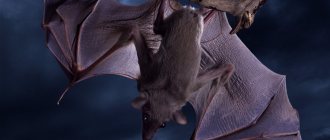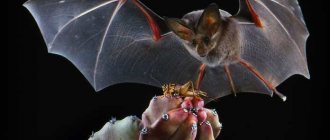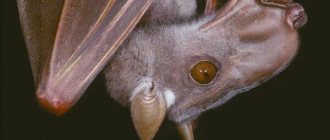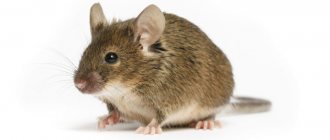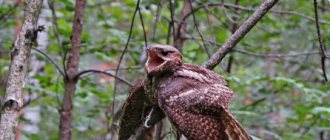Chiroptera - belongs to the class mammals. They are capable of flight thanks to modified forelimbs and use flight as the main method of movement.
Chiropterans and birds are the only representatives of chordates that inhabit the air. At the same time, birds are active during the day, and bats at night, which eliminates competition for occupied space. There is a separate science of chiropterology .
Order Chiroptera - bats
Unusual representatives of mammals
The characteristics of bats primarily lie in their ability to fly. This becomes possible thanks to the special structure of the upper limbs. But they are not turned into wings at all. The thing is that along the entire body from the last phalanx of the second finger to the tail there is a fold of skin. It forms a kind of wing. The order Chiroptera has another similarity with birds. Both of them develop a special outgrowth of the sternum - the keel. It is to this that the muscles that move the wings are attached.
Structural features of Chiroptera
The wings of chiropterans are a thin membrane of skin stretched between the fingers, with the exception of the first, and is attached to the sides of the body, hind limbs and tail. With the help of the first finger, bats grab onto the bark of trees and ledges of rocky caves when completing their flight. During the cold season, animals wrap their bodies with wings to retain heat.
During flight, bats actively flap their wings. The fingers move away from each other, the leathery membrane stretches, which increases the area of the wing. Its elasticity allows it to stretch approximately four times without damage. The constant flapping movement caused significant development of the pectoral muscles. Representatives of the order Chiroptera have a developed keel on the sternum, where the muscles are attached.
Bats can begin flight not only from high-altitude points, but also take off from the ground and even from bodies of water, and the flight begins with a strong upward jump.
On the head there are small eyes, a wide mouth in the form of a slit, large ears with a tragus. During daytime sleep, the tragus closes the ear canal and isolates the animal from extraneous sounds. The body is covered with dense short hairs; there are much fewer of them on the wings.
The internal structure of the skeleton of chiropterans has its own characteristics: for efficient and maneuverable flight, their clavicles are well developed, the ulna and fibula are not developed, the humerus is shorter than the radius. A bone has formed on the hind legs - a spur for attaching the interfemoral membrane.
Bat wing structure
Sense organs . Tactile receptors are located on the skin membranes, ears, vision is black and white, rarely used for orientation. The hearing is very developed, they can perceive sounds in the range of 12-190000 Hz.
Reproduction of bats . The female is capable of giving birth to one or two cubs, quite large in size. Immediately after birth, they can hold onto rough surfaces by clinging to protrusions. When the female goes hunting, the baby remains alone in the cave, and some species carry the baby on themselves until it can fly on its own.
Order Chiroptera
These animals are nocturnal. During the day they sleep, and at dusk they fly out from their shelters to hunt. Their habitats are caves, mines, hollows of old trees, and attics of houses. Chiropteran mammals have all the characteristic features of this class. They feed their young with milk, have hair, epidermal formations - claws, and their skin contains numerous glands: sebaceous, sweat and milk. Chiropterans see very poorly. This is a characteristic feature of nocturnal animals. But this is compensated by absolute hearing, which is more important in complete darkness. In order to navigate in such conditions, bats also have additional adaptations.
Reproduction
The gestation period in bats lasts from 50 to 60 days. Most females give birth to a single cub once a year, but in some species, such as the pale smoothnose, twins are common, and the rufous hairtail often gives birth to 3 or 4 cubs. Usually bats are born naked and blind, but there are exceptions; in particular, the red fruit-eating leaf-nosed insect has fur-covered newborns. Newly born bats are relatively large, reaching a third of their mother's weight. Like other mammals, they are fed milk. At the age of two weeks, the cub reaches half the body size of an adult, but cannot yet fly; When leaving to feed, the mother leaves him in the colony. If the colony is disturbed, the females often move the babies to a new place: during the flight they hold on to the mother's nipples. Some bats, such as false horseshoe bats, even have special false nipples for this purpose. At about three weeks of age, young animals begin to fly.
What is echolocation?
Chiropteran mammals, or rather most of them, are capable of emitting high-frequency sound signals. Other living organisms cannot perceive them. Such signals are reflected from surfaces encountered along the animal’s path. Thus, chiropteran mammals easily navigate in complete darkness and move freely in such conditions. This ability also allows them to hunt for prey in the air. To make it even better at catching sound signals, all animals of this order have characteristic, well-developed ears.
Real vampires
There are many terrible legends about winged mammals. They say they all attack people at night, feeding on their blood. However, all these rumors are greatly exaggerated. For example, bulldog bats hunt insects at high altitudes. And many species of fruit bats feed on sweet fruits, causing significant damage to agriculture and horticulture.
But in South and Central Africa there really are real vampires. Their feature is the presence of pointed edges of the upper incisors. They act like a razor. Vampires use them to cut the surface of the skin of animals or humans and lick the blood from this place. Such a wound can be very dangerous. The thing is that the saliva of vampires contains a substance that prevents blood clotting. The victim does not always feel the bite, since the secretions also contain painkillers. Very often the wound becomes very inflamed. Such tropical vampires can also be carriers of dangerous diseases, such as rabies. Therefore, they cause great harm to livestock.
Diversity of the bat order
Representatives of bats are divided into two groups: fruit bats and bats. The former prefer to live in the countries of Australia, Asia and Africa. In food they give preference to fruits. Therefore, they do not need to hunt. Due to this feature, their echolocation is much less developed than that of other representatives of winged mammals. But this is compensated by excellent vision and sense of smell. Bats, unlike fruit bats, are mostly predators and blood-sucking animals. Echolocation helps them in night hunting. Such individuals live up to 20 years. Let's take a closer look at some amazing representatives of chiropteran mammals.
Way of life
Despite the fact that the order Chiroptera consists of a huge number of species that live in different natural conditions, their way of life differs little from each other.
Bats live in flocks: in the places where they have settled, there are from fifty to one hundred flying animals per square kilometer. They lead a nocturnal lifestyle, because it is during this period that it is easier for them to get food for themselves and hide from enemies; during the day they sleep, hanging upside down. Relatives communicate with each other using both ultrasonic and ordinary sounds.
In addition, if bats live in temperate latitudes, during the cold period of the year some species go into long-term hibernation (for example, the pipistrelle bat). Before falling into torpor, the animals, hanging upside down, wrap themselves in their wings, as if in a cloak, and press closely together to reduce heat loss.
As a result, the metabolic rate and breathing intensity decrease, the heart begins to beat less frequently, and the body temperature drops to zero degrees. The animals wake up no earlier than the warmth arrives (in some cases they are able to sleep for up to seven months).
True, not all inhabitants of cold latitudes hibernate: some of them migrate far to the south, and an interesting fact is that winged animals, like birds, fly in constant routes, fly away at the same time, and always come to breed home.
Reproduction
Despite the fact that bats do not live long, on average about five years, the ability to reproduce comes late, at the age of two years, pregnancy lasts 16 weeks, and the female gives birth to only one baby.
This is due to their way of life. A pregnant female needs to continue active flights in search of food, and the baby is born rather large: its size is 25% of the mother’s body. Having been born, at first, until he learns to fly, he remains on his mother’s back, and she has to carry her baby during the flight.
Another interesting fact is that temperate bats give birth once a year, mostly in late spring/early summer: at this time their food, insects, appears in abundance. At the same time, in tropical latitudes, where food is constantly available, bats breed twice, and some species even three times a year.
During childbirth, females bend the interfemoral membrane in such a way that a kind of cradle is obtained into which the baby is rolled out (this is especially true for species that give birth upside down, for example, eared ones).
Despite its large size, the cub is born naked, blind, without hair, its mouth resembles a narrow slit, and its ears resemble crumpled paper. Its paws and thumbs are very large and already equipped with claws, with which it clings to its mother’s fur with a death grip. The remaining fingers, between which the membrane is located, are still undeveloped. But such a disproportion does not last long: the baby grows up quickly, and his body soon acquires the desired shape, and his wings grow (young animals begin their first flights at the age of 3 to 6 weeks).
Nutrition
The question of what bats eat has been worrying the minds of a huge number of people for more than a millennium, and many are convinced that bats feed only on human blood.
In reality, everything is not so scary: only three species of mammals feed on blood, and even those are found in southern Africa and the South American continent. Vampire bats feed mainly on the blood of animals and rarely attack people: having made a cut in the skin with sharp teeth, they greedily drink blood (do not suck), which flows without stopping, since their saliva contains a component that prevents blood from clotting. Despite the fact that the bites are painless, they are dangerous because the animals are carriers of rabies.
The rest of the bats are safe for people and even beneficial, since most of them are insectivores. In an hour of hunting, one animal can eat about two hundred mosquitoes. Larger species, for example, the largest bat in the world, the false vampire, hunt frogs, small birds, and lizards. Some species eat fish, and among them there are those that also hunt relatives that belong to other species.
Interesting facts about raccoons95644.714
An equally interesting fact is that among bats there are also vegetarians who feed exclusively on flower nectar, berries, fruits, pollen, and nuts. Animals that prefer the nectar of flowers not only feed on them, but also pollinate them (the length of the tongue of these creatures is ¼ of the body length).
Fruit bats
Kalongs, or flying dogs, and acerodons are representatives of bats from the fruit bat family. These are quite large individuals. Thus, their wingspan can reach more than 1.5 meters. However, the size of some species that feed on pollen and nectar of plants is 5 cm. They have practically no tail. Instead, there is an underdeveloped coccygeal region. Their body is completely covered with hair up to 3 cm in length. Their color is most often brown, but there are species in both yellow and green shades with spots all over the body.
In search of food, fruit bats can cover a distance of up to 100 km in a day. At the same time, they unite into huge flocks, the number of individuals reaching several tens of thousands. In November, fruit bats form married couples, and by the end of February they already have offspring. The number of newborns usually does not exceed 2 individuals. At about the age of 8 months, they are already able to obtain food on their own. There are known cases when people tamed fruit bats.
Nutrition
Chiropterans eat a variety of foods, but the diet of each family is highly specialized. Most consume insects (about 625 species), but there are species that feed on flowers, nectar, pollen and fruit. There are also predators that feed mainly on small vertebrates (birds, rodents, amphibians, reptiles and bats). At least 3 species catch small fish by grasping them with their hind claws at the surface of the water (the great angler, the fish-eating bat and the Indian false vampire). Three species of bats from the tropics of the New World (American vampires from the family Phyllostomidae) attack large animals or birds, cut off pieces of skin with their incisors and lick the blood.
Vechernitsy
These bats are known for being the largest representatives of chiropterans in all of Europe. Unlike others, they do not hibernate, but make long-distance seasonal migrations. Their diet is quite varied, but butterflies and beetles predominate in it. But the giant noctule is not averse to feasting on even small songbirds. This is the rarest species. Often these animals fly out to hunt together with swallows or swifts. Swooping over the water, they drink. The rufous noctule is especially fond of cockchafers or beetles.
Description and features
Chiroptera (Chiroptera) is the only order of mammals whose representatives are capable of active flight - this feature allows them to use resources that are inaccessible to other animals. Chiropterans are the second largest order of mammals (after rodents) - about 1,200 species are known. Chiropterans are extremely diverse and inhabit all continents of the Earth, with the exception of Antarctica. These are small and medium sized animals. The smallest species, the pig-nosed bat, is generally the smallest modern mammal - its length is 29 mm and its weight is 1.7 g; the largest bat is the Kalong flying fox, up to 40 cm long and weighing 1 kg with a wingspan of 1.5 m. The forelimbs of chiropterans are transformed into wings, but in a significantly different way than those of birds. All fingers of their “hands,” except the first, are greatly elongated and, together with the forearm and hind limbs, serve as a frame for the skin membrane that forms the wing. Most species have a tail, which is usually also covered by a flight membrane. The membrane is permeated with blood vessels, muscle fibers and nerves. In cold weather, bats can wrap themselves in their wings like a cloak. The bones of chiropterans are small and thin, which is an adaptation for flight. Most bats cannot match the flight speed of faster birds, but in the bats it reaches approximately 30-50 km/h, in the great brown leatherback 65 km/h, and in the Brazilian folded lip almost 100 km/h. The hind limbs of chiropterans are turned outward, probably to facilitate landing upside down and hanging on the toes; This causes the knees to bend backward.
The head of bats has a wide oral slit, small eyes and large, sometimes complexly arranged auricles with a skin outgrowth at the base of the ear canal. On the front part of the head, some species have complex, bare, leathery formations. The organs of touch of chiropterans are diverse and, in addition to the usual tactile corpuscles and vibrissae, are represented by numerous thin hairs scattered on the surface of the flight membranes and auricles. Their vision is weak and is practically not used for orientation, but their hearing is exceptionally fine and the range of audibility is enormous: from 12 to 190,000 Hertz. To navigate in space, many species of bats use echolocation: the ultrasonic pulses they emit are reflected from objects and captured by the ears. When preparing for flight, the animal emits from 5 to 10, and in front of an obstacle - up to 60 pulses per second. The ultrasounds reflected from the obstacle are perceived by the bat's hearing organs, which provides orientation in flight at night and the prey of flying insects. In addition to ultrasound, these animals also use regular sound signals to communicate.
Spectacled flying fox
This species can most often be found in the vastness of the Indonesian Peninsula and Australia. These representatives of bats have a characteristic feature due to which they got their name. The fact is that around their eyes the fur grows in the form of a mask and is lighter in color. Externally, these are very similar to real glasses. They usually also go for food at night, uniting in large flocks. They prefer plant foods. For example, nectar from tropical plants. By obtaining this sweet delicacy, they thereby contribute to the process of pollination of flowers. Eucalyptus and figs are the favorite foods of flying foxes.
Chiropterans and their colonies
- KEY FACTS
- Distribution: Worldwide, in temperate, subtropical and tropical regions
- Number of a typical colony: from 20 to 20 million individuals
- Gestation period: 2-4 months; in many species, fertilization of the egg occurs a long time after mating
- Gaining independence: 10-12 weeks
- Territories: Plot of various sizes. Species living in temperate climates migrate in winter
The pipistrellus (Pipistrellus) is a small insectivorous bat with brown fur, distributed almost throughout the world. Although pipistrelle bats usually hunt alone, they are highly social animals.
Chiropterans are the second largest order of mammals after rodents. It unites about 900 species, distributed almost throughout the world.
The order Chiroptera includes two suborders: fruit bats, or fruit-eating chiroptera (Megachiroptera) and bats, or insectivorous chiroptera (Microchiroptera). This division, however, is somewhat imprecise. While all frugivorous bats feed exclusively on plant foods (fruit pulp, nectar and flower pollen), many species of insectivorous bats feed not only on insects. Let's look at the social organization of fruit bats, focusing on flying foxes, and then turn to bloodsucking bats (sometimes called vampire bats), in particular insectivorous bats.
Flying foxes
In the suborder of fruit bats there is only one family, fruit bats (Pteropidae), which includes about 200 species.
Often all representatives of this family are called flying foxes, because in appearance they resemble these animals (large eyes, pointed ears and reddish fur). A huge colony of bats that go in search of food at dusk. The photo was taken in Backute Bay near the island of Palawan (Philippines).
Fruit bats live only in the tropics and subtropics, feeding on flowers, nectar and fruit pulp. The most famous species of flying fox, the grey-headed flying fox (Pteropus poliocepbalus), is distinguished by the distinct social organization of its communities.
Tree camps
Nesting colonies (camps) of gray-headed flying foxes number up to 50 thousand individuals and are located in the crowns of large trees. Due to the accumulation of such a large number of animals, it is not easy to determine whether a particular individual belongs to a given colony. In order for flying foxes to be accepted into a colony, they wet themselves with their own urine. Before forming a colony, males compete with each other for the right to increase the territory (a section of a branch 1-2 m long), the boundaries of which are marked by the aromatic secretions of the host's brachial glands. Males often fight, but when neighbors recognize established boundaries, life in the colony becomes calmer. Females arrive later. They give birth to their young in small areas located closer to food sources. When they settle in the territory of males, there are usually one or two females for each of them. If necessary, females help the male defend the territory.
Noisy rituals
Having settled in their area, flying foxes mate several times within one to two hours.
During the day, to conserve heat, bats gather in dense groups and hang upside down. If a threat appears, they scream shrilly and flap their wings.
At this time, the males emit loud, piercing screams, warning other males about mating. Therefore, during the breeding season, constant noise is heard in the flying fox colony. In addition, when communicating with each other, flying foxes use up to 20 loud sound signals.
Small groups of adults living on the outskirts of the territory occupied by the colony act as sentinels. These are mostly young males who do not form family groups. Possessing keen eyes and acute hearing, in case of danger they scream loudly and flap their wings.
The dense foliage of the tree on which the colony is located is home to young flying foxes. At night, when the adults fly away in search of food, the young remain with the cubs - nannies who take care of the babies until the parents return. In colonies of flying foxes there are also “teachers” - adult animals that often accompany groups of young animals on flights for food. They show them the way, teach them behavior and self-feeding skills.
Western piping bird in the forests of South Western Australia.
Insectivorous bats
There are significantly more species of bats than fruit bats.
But a social organization similar to that inherent in flying foxes is less common among them. This may be due to differences in the feeding habits of fruit bats and fruit bats. The main food of fruit bats is fruits and flowers. Since such food is concentrated in one or several trees, fruit bats feed together, and this social organization of the flock brings some benefits. Bats feed on insects, which they can hunt alone. Many species of these bats live in colonies, but this is often due to the desire to protect themselves from predators and reduce heat loss, rather than the advantages of social organization. Insectivorous species form two types of colonies. The first type is a nursery colony: pregnant and lactating females, sometimes with growing cubs. Males in most cases live separately, alone or in small groups and appear in the colony only to mate. The second type is a colony created for wintering, in which males and females gather. Colonies of this type are more often found in regions with temperate climates, where during the cold season bats gather in large groups and hibernate. Wintering is often preceded by migration to warmer regions.
A huge colony of bats has found refuge in a temple on the Indonesian island of Bali.
Colonies of insectivorous bats can reach enormous sizes. The largest colony, which is located in Bracken Cave in Texas (USA), is home to about 20 million Brazilian folded lips (Tadarida brasiliensis). The colony is so large that the female often cannot find her young (often the only one) and therefore feeds anyone. Her milk is enough to feed several babies, so all the babies in the colony receive the required amount of food. The body heat of many individuals in the colony increases the temperature inside the cave, which also contributes to the survival of the young.
Bloodsuckers
One of the few species of insectivorous bats that exhibit complex social behavior is the bloodsucker (Desmodus rotundus).
They are often called vampires, although bats of the genus Vampyrum called vampires are frugivores. They feed on the blood of mammals. Bloodsuckers live in the tropics and subtropics of Central and South America. The wingspan reaches 20 cm, and the body weight does not exceed 30 g. Bloodsuckers are nocturnal animals. They spend their days in colonies of up to 100 individuals, located in caves or hollows of large trees. Typically a colony consists of several families, each of 8-10 females and their young. Adult males are not associated with families; their only function in the colony is to mate with females. Every night, adults leave the cave in search of victims, whose blood they feed on. Pregnant and lactating females typically emerge earlier and hunt longer than males as they seek more food for themselves and their young. Often, when flying to a hunting place and returning, bloodsuckers navigate along rivers. Typically, their colonies are located near feeding areas, and if the food source becomes scarce, the colony moves and occupies new territory. Bloodsuckers prefer the blood of large domestic animals (cows, horses or pigs), but can also feed on the blood of poultry or humans.
Since seasonal climate changes in the regions where bloodsuckers live are insignificant, they mate at any time of the year. After mating, several months may pass before the egg is fertilized, during which the female stores the male's sperm. Pregnancy lasts from three to four months.
It is so warm on the island of Sulawesi (Indonesia) that frugivorous bats do not need to huddle together in a dense group while sleeping. Some of the inhabitants of the colony remain awake, fearing the appearance of predators.
The first few days after birth, the cub clings tightly to its mother, not leaving her even at night when she goes in search of food. However, he quickly gains weight, and his mother is forced to leave him alone in the nest at night. The cubs' eyes open a week after birth, and they begin to fly at the age of three weeks. At 10-12 weeks they gain independence, females remain in their family group, and males leave it.
Behavior and nutrition
Bloodsuckers exhibit a complex social behavior known as reciprocal altruism.
This is a kind of mutual assistance: one individual helps another, knowing that if necessary, it will also not be left in trouble. This behavior is typical only for females. Whether males behave this way is unknown. Mutual assistance in colonies of bloodsuckers is expressed in the form of feeding. After a successful hunt, a satiated bat regurgitates its food and shares it with a relative who was unlucky in the hunt. Bloodsuckers can feed only while remaining unnoticed by their victims, so the hunt is often unsuccessful. A large animal easily throws off a discovered bloodsucker. Especially often young individuals who have not yet mastered the art of hunting remain hungry. Usually, the hunt of every third young and every tenth adult bat is unsuccessful. It should be noted that due to their small body weight, regular feeding is of great importance for bloodsuckers - without food they die within three days.
Food is shared only by relatives or individuals who have lived nearby for a long time and know each other well. Bloodsuckers never feed “strangers.” The bat that often shares food is more likely to receive help than others. Scientists suggest that bloodsuckers themselves determine which individual needs help the most. A mouse that has not eaten for two days is more likely to get food than a mouse that has been starving for the first day. And although the noble act of a generous animal does not bring immediate benefits, it does provide help from its relatives if necessary.
- Did you know?
- Colonies of frugivorous flying foxes number up to 250 thousand individuals, and the largest colony of insectivorous bats is home to about 20 million animals.
- In a year, a colony of blood-sucking bats can drink an amount of blood equivalent to the total blood volume of 25 cows.
- Some species of bats live in the burrows of wild rabbits, porcupines and old bird nests.
- There are species of bats that have false nipples. When the mother flies out to hunt, the cub clings to them so as not to fall.
The importance of chiropteran mammals in nature and human life
The representatives of the animals discussed in our article bring both benefit and harm through their life activities. For example, in Pakistan, the flying dog is intensively hunted illegally because it has very valuable fat. In some countries, chiropteran dishes are an exquisite delicacy. It is known that in ancient times the Incas decorated their clothes with the fur of these animals. Moreover, such an outfit was a sign of wealth and power. There are cases where bats ate forest pests in large quantities, thereby promoting its growth. Chiropterans feeding on fruits contribute to their distribution. Overcoming considerable distances during the day, bats and fruit bats also carry their seeds. Together with undigested food debris, they end up in the soil, far from the growing area. All this contributes to the spread of many plant species across the surface of the planet.
Representatives of bats occupy their important niche in the food chains of many ecosystems. They not only destroy various living components of biocenoses. By carrying dangerous infectious diseases, they are able to regulate their numbers. The negative significance of bats is also due to the fact that, feeding on juicy fruits, they increasingly prefer to feast on them in gardens, causing significant damage to the harvest. These animals, being the basis of myths and legends about vampires, are often safer than many others. So, the order Chiroptera is the only systematic group of the class of mammals capable of active flight due to the presence of a keel and skin folds that form wings.
Flying animals
Bats are the name given to mammals that belong to the order Chiroptera, whose representatives can fly. At the same time, the flight of a bat is so specific that it is impossible to confuse its movement with the flight of other representatives of the animal world: with their thin and large wings resembling parachutes, they seem to constantly push off from air masses (the name of this type of movement is “propulsion”).
The order Chiroptera includes 1,200 species (forty of them live in Russia) and includes two suborders: one family – fruit bats, seventeen – bats. Their numbers are so large that they account for 20% of the total number of all species of mammals on the planet.
Koalas are the original representatives of the living world of Australia95644.811
Bats live on all continents of the globe except Antarctica. You also won’t see them in the tundra and subpolar regions. Most species prefer to live in the tropics, although representatives of the order can also be found in the middle zone. For example, if in temperate latitudes the population density of animals ranges from 50 to 100 per km2, in Central Asia these figures reach thousands. On many islands in the ocean, bats are the only land mammals, since only they can easily overcome long distances over the sea.
